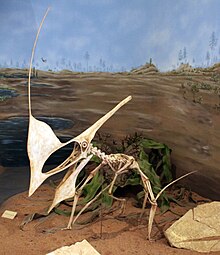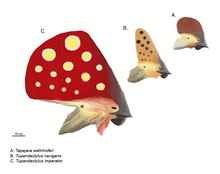Tupandactylus
| Tupandactylus | |
|---|---|

| |
| Reconstructed T. imperator skeleton, National Museum of Brazil | |
| Scientific classification | |
| Domain: | Eukaryota |
| Kingdom: | Animalia |
| Phylum: | Chordata |
| Order: | †Pterosauria |
| Suborder: | †Pterodactyloidea |
| Family: | †Tapejaridae |
| Subfamily: | † Tapejarinae
|
| Tribe: | † Tapejarini
|
| Genus: | †Tupandactylus Kellner & Campos, 2007 |
| Type species | |
| †Tapejara imperator Campos & Kellner, 1997
| |
| Species | |
| |
| Synonyms | |
|
List of synonyms
| |
Tupandactylus (meaning "Tupan finger", in reference to the
.History

Tupandactylus imperator is known from four nearly complete skulls. The
A 2021 study describing a very complete T. navigans specimen suggested that the two species might represent different sexes of one
Description
Tupandactylus is notable for its large cranial crest, composed partly of bone and partly of soft tissue. The genus Tupandactylus possibly contains two species, both bearing differently sized/shaped crests that may have been used to signal and display for other Tupandactylus, much as

Tupandactylus crests consisted of a semicircular crest over the snout, and in the case of the type species T. imperator, a bony prong which extended back behind the head. A second species, T. navigans, lacked this prong, and had a much more vertical crest.
Soft tissue impressions also show that the small bony crests were extended by a much larger structure made of a keratinous material. The complete crest of T. navigans rose in a sharp, sail-like "dome" high above the rest of the skull.
Some Tupandactylus specimens preserve evidence of a keratinous beak at the jaw tips. However, this was restricted to the crested portion of the lower jaw, as one specimen also preserves
T. imperator is estimated to have had a wingspan about 3 to 4 meters (9.8 to 13.1 ft), while T. navigans is smaller, with a wingspan of 2.7 meters (8.9 ft).[4][5]
A 2022 study reported vaned feathers near the base of the crest of a T. cf. imperator specimen.[6]
Classification

Beginning in 2006, several researchers, including Kellner and Campos (who named Tupandactylus), had found that the three species traditionally assigned to the genus Tapejara (T. wellnhofferi, T. imperator, and T. navigans) are in fact distinct both in anatomy and in their relationships to other tapejarid pterosaurs, and thus needed to be given new
The cladogram below follows the 2014
| Azhdarchoidea |
| ||||||||||||||||||||||||||||||||||||||||||||||||||||||||||||||||||||||||||||||
Paleobiology

Tupandactylus navigans may have largely been a terrestrial forager. Examination of the specimen GP/2E 9266 suggests that the pterosaur was capable of flight, but seemingly spent much of its time on the ground thanks to its large crest, longer forelimbs and neck, only taking short flights to possibly escape from predators. Simultaneously, it was not adapted to the same terrestrial stalking lifestyle as
Pterodrone unmanned aerial vehicle
A research team consisting of paleontologist Sankar Chatterjee of Texas Tech University, aeronautical engineer Rick Lind of the University of Florida, and their students Andy Gedeon and Brian Roberts sought to mimic the physical and biological characteristics of this pterosaur—skin, blood vessels, muscles, tendons, nerves, cranial plate, skeletal structure, and more—to develop an unmanned aerial vehicle that not only flies but also walks and sails just like the original, to be called a Pterodrone.[12] The large, thin rudder-like sail on its head functioned as a sensory organ that acted similarly to a flight computer in a modern-day aircraft and also helped with the animal's turning agility. "These animals take the best parts of bats and birds," Chatterjee said. "They had the maneuverability of a bat, but could glide like an albatross. Nothing alive today compares to the performance and agility of these animals. They lived for 160 million years, so they were not stupid animals. The skies were darkened by flocks of them. They were the dominant flying animals of their time." "[W]e've found they could actually sail on the wind for very long periods as they flew over the oceans.... By raising their wings like sails on a boat, they could use the slightest breeze in the same way a catamaran moves across water. They could take off quickly and fly long distances with little effort."[13]
The accuracy of these studies has been contested by paleontologist Mark Witton, however. It has been noted that tapejarids had short wings, about as suited for soaring as those of Galliformes, which are indeed consistent with adaptations for terrestriality and climbing. Likewise, no evidence for an aerodynamic function of the crest has been perceived,[14][15] and Sankar Chatterjee seemingly ignored more recent aerodynamic studies in pterosaurs for these conclusions.[16]
See also
References
- ISBN 978-0-521-85867-0
- ^ Campos, D.A.; Kellner, A.W.A. (1997). "Short note on the first occurrence of Tapejaridae in the Crato Member (Aptian), Santana Formation, Araripe Basin, Northeast Brazil". Anais da Academia Brasileira de Ciências. 69 (1): 83–87.
- ^ a b Kellner, A.W.A.; Campos, D.A. (2007). "Short note on the ingroup relationships of the Tapejaridae (Pterosauria, Pterodactyloidea". Boletim do Museu Nacional. 75: 1–14.
- ^ PMID 34432814.
- ^ .
- S2CID 248298392.
- ^ Unwin, D. M. and Martill, D. M. (2007). "Pterosaurs of the Crato Formation." In Martill, D. M., Bechly, G. and Loveridge, R. F. (eds), The Crato Fossil Beds of Brazil: Window into an Ancient World. Cambridge University Press (Cambridge), pp. 475–524.
- ^ Naish, D. (2008). "Crato Formation fossils and the new tapejarids." Weblog entry. Tetrapod Zoology. January 18, 2008. Accessed January 31, 2008 ("Tetrapod Zoology : Crato Formation fossils and the new tapejarids". Archived from the original on July 6, 2008. Retrieved November 15, 2008.).
- PMID 24768054.
- PMID 34432814.
- .
- ^ "Pterodactyl-Inspired Robot To Master Air, Ground And Sea". Geological Society of America. ScienceDaily. October 2, 2008. Retrieved July 1, 2012.
- ^ "Ancient Airways: Flying Drone Design Based On Prehistoric Flying Reptile". Texas Tech University. ScienceDaily. October 13, 2008. Retrieved July 1, 2012.
- ^ Witton, Mark (January 25, 2011). "Pterosaur.net Blog: What despair, pterosaurs and David Attenborough have in common".
- ^ Witton, Mark P. Pterosaurs: Natural History, Anatomy, Evolution
- ^ Witton, Mark (November 11, 2012). "Pterosaur.net Blog: How giant pterosaurs are struggling to take off from the sinking ship of science journalism".
